Wondering how much your 1952 Wheat Penny is worth?
As a coin from over 70 years ago, you might assume it carries a hefty price tag. But in most cases, the value of a 1952 Wheat penny depends heavily on its condition, as well as rarity and the possible presence of minting errors.
Despite being common, this Lincoln Wheat cent is a great piece for collectors, especially for those working on a complete 1950s penny set. And the best part? Most of these coins are quite affordable, making them easy to add to your collection without spending a fortune.
In this guide, we’ll break down everything you need to know about the 1952 Wheat penny’s value — from its background and design to grading insights and rare errors that could boost its price significantly.
Let’s get started with a look at the value chart:
1952 Wheat Penny Value Chart (Red coins only)
| Mint Mark | MS63 | MS64 | MS65 | MS66 / PF66 |
|---|---|---|---|---|
| 1952 (No Mint Mark) | $6 | $16 | $24 | $100 |
| 1952-D (Denver) | $7 | $12 | $22 | $30 |
| 1952-S (San Francisco) | $10 | $18 | $24 | $35 |
| 1952 Proof (Philadelphia) | – | – | – | – |
History of the 1952 Wheat Penny
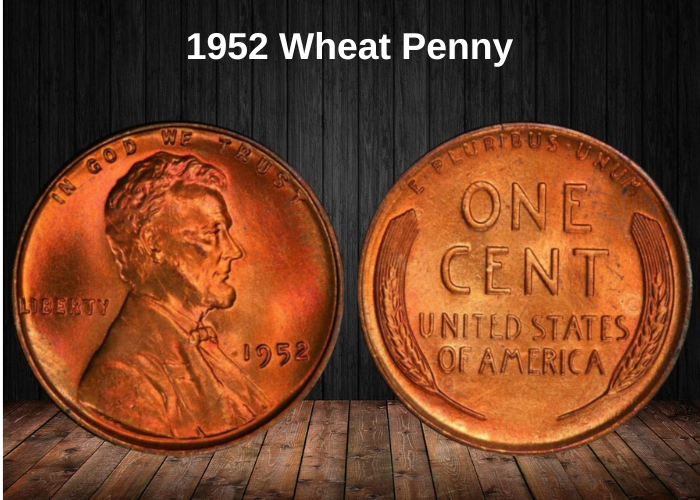
The 1952 Wheat penny is part of the iconic Lincoln cent series, which began in 1909. This series marked a major shift in American coin design—it was the first U.S. coin to feature a real person, and fittingly, it was a president: Abraham Lincoln.
Before this, American coins had generally avoided real human figures, as doing so was seen as too reminiscent of monarchy. But President Theodore Roosevelt, always a reformer, pushed for a more artistic and symbolic approach to U.S. currency. In 1904, he proposed a redesign of several coins, including the Indian Head cent, and brought in renowned sculptor Augustus Saint-Gaudens to lead the effort.
While Saint-Gaudens successfully redesigned four gold coins, he passed away from cancer in 1907 before completing his work on the cent. Roosevelt didn’t let the idea fade, especially with Lincoln’s 100th birthday approaching in 1909. Wanting to honor the beloved president, Roosevelt had the Mint commission Victor David Brenner to take over the cent’s redesign.
Brenner’s design was simple yet meaningful. The obverse featured a right-facing profile of Lincoln, while the reverse showed two wheat stalks flanking the coin’s denomination—earning it the nickname “Wheat penny” or “Wheat cent.”
The Wheat penny remained in production from 1909 to 1958, all struck in a 95% copper alloy until 1982, when rising copper prices led to a switch to zinc coins with a thin copper coating. In 1959, the design transitioned to the Lincoln Memorial reverse, created by Frank Gasparro, to mark Lincoln’s 150th birthday.
Features of the 1952 Wheat Penny
The Obverse of the 1952 Wheat Penny
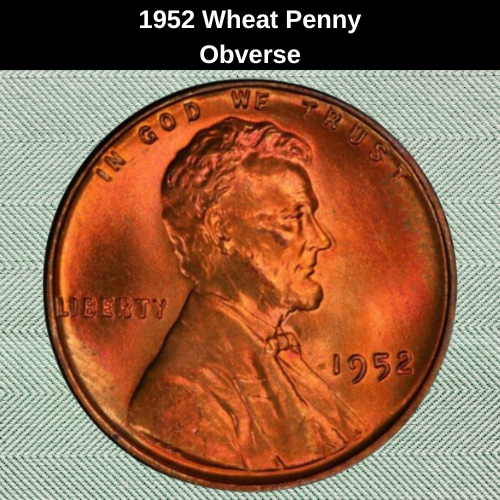
The obverse of the 1952 Wheat penny features a detailed right-facing portrait of Abraham Lincoln, which dominates the front of the coin. Above his head, along the upper rim, is the national motto “IN GOD WE TRUST.” To the left of Lincoln’s profile, you’ll see the word “LIBERTY,” while the date “1952” is inscribed to the right.
The Reverse of the 1952 Wheat Penny
The reverse of the 1952 Wheat penny features a clean, minimalistic design. On either side of the coin, you’ll see two stylized wheat ears, which give the coin its nickname. In between them, at the center, are the inscriptions “ONE CENT” and “UNITED STATES OF AMERICA.” Arched along the top edge is the Latin motto “E PLURIBUS UNUM,” meaning “Out of many, one.”
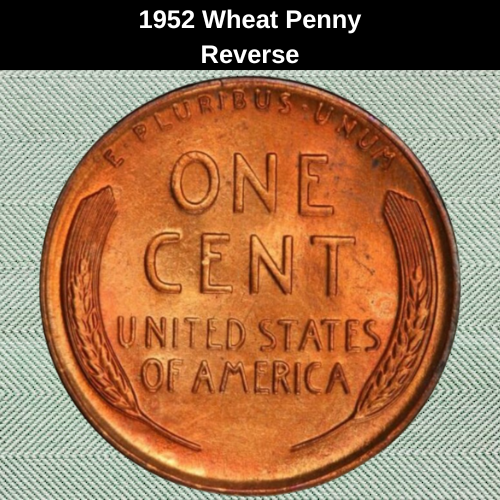
Other Features of the 1952 Wheat Penny
Wheat pennies from 1952—like others in the series—come in different color grades depending on their condition. Circulated coins typically appear brown or red-brown, while uncirculated examples retain their original bright red hue.
The coin features a plain edge, has a diameter of 19.00 millimeters, and weighs 3.11 grams. Its composition is the classic 95% copper and 5% tin and zinc alloy, consistent with other Wheat cents of the era.
In 1952, the Philadelphia, Denver, and San Francisco Mints all struck Lincoln Wheat pennies in high volumes. You can identify coins from Denver and San Francisco by the “D” and “S” mint marks located just below the date on the obverse.
1952 Wheat Penny Grading Guide
When it comes to collecting 1952 Wheat pennies, uncirculated examples are the most sought-after. These coins exhibit full luster, glossy surfaces, and no signs of wear—hallmarks of a well-preserved piece.
To determine if your penny qualifies as uncirculated, focus on key high points:
- On the obverse, inspect Lincoln’s cheek, beard, and the front edge of his coat. These areas should retain their original luster and remain untouched by wear.
- On the reverse, examine the ONE CENT lettering and the wheat ears. These raised features should display consistent frost and shine, with no dull or worn spots.
Below is a basic guide to grading:
| Grade Number | Grade Description |
|---|---|
| 1 | Basal State-1 |
| 2 | Fair |
| 3 | Very Fair |
| 4 – 6 | Good |
| 7 – 10 | Very Good |
| 12 – 15 | Fine |
| 20 – 30 | Very Fine |
| 40 | Extremely Fine |
| 50 | About Uncirculated |
| 60 | Mint State (MS60) |
| 65 | Mint State (Gem – MS65) |
| 70 | Mint State (Perfect – MS70) |
Before estimating the value of your coin, it’s essential to accurately determine its grade. Reference a professional grading guide or consult a certified grading service if you’re unsure.
1952 Wheat Penny Value Guides
So, how much is a 1952 Wheat Penny worth?
The value of a 1952 Wheat Penny can vary widely depending on a few key factors:
- Condition – Uncirculated coins in pristine condition are always worth more than circulated or worn examples.
- Mint Mark – Coins from different mints may carry different values due to differences in mintage numbers and survival rates.
- Color – Wheat pennies are graded as Brown (BN), Red-Brown (RB), or Red (RD). Fully red coins tend to be the most valuable.
- Rarity and Errors – Coins with minting errors or in particularly rare grades can command premium prices.
There are four main varieties of the 1952 Wheat Penny, and we’ll explore the value of each:
- 1952 No-Mint Mark Wheat Penny (Struck in Philadelphia)
- 1952-D Wheat Penny (Struck in Denver)
- 1952-S Wheat Penny (Struck in San Francisco)
- 1952 Proof Wheat Penny (Special collector-only strikes)
In the following sections, we’ll break down each variety and its current market value based on condition and grade.
1952 No-Mint Mark Wheat Penny Value
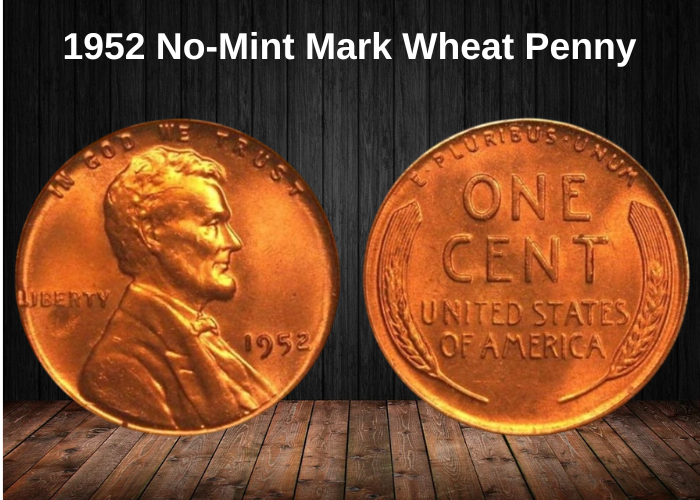
The Philadelphia Mint struck a substantial 186,775,000 wheat pennies in 1952. While most of these coins were well-struck and are still widely available, finding flawless, blemish-free examples—especially in higher grades—isn’t always easy.
Although full red specimens are relatively common, certified gem-quality red coins are considerably rarer and more valuable.
- In circulated condition, a 1952 no-mint mark red penny is worth between $0.05 and $0.35, just slightly over its face value.
- In mint state, prices remain modest:
- MS64 RD: Around $16
- MS66 RD: About $100
However, values increase significantly for top-tier coins:
- MS67+ RD examples are rare and can reach up to $6,750.
- The record price for a 1952 Philadelphia penny was $9,775, paid at auction in 2007 for a coin graded MS67 RD.
These numbers show that while many 1952 wheat pennies are affordable, the highest-grade coins can be a serious prize for collectors.
1952-D Wheat Penny Value
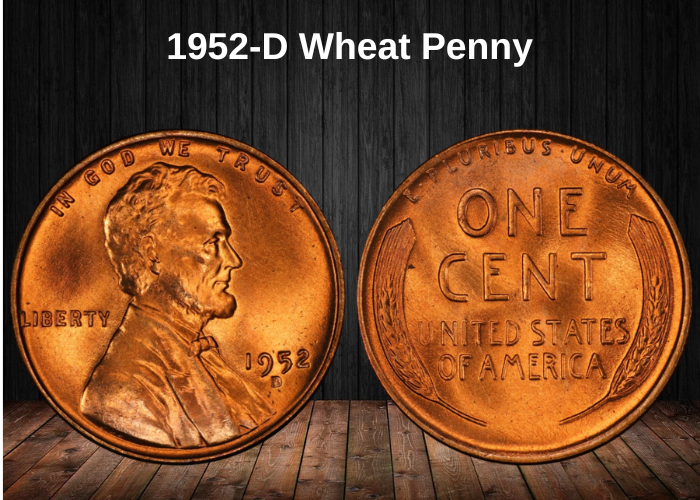
The Denver Mint holds the record for the highest mintage of wheat pennies in 1952, producing a staggering 746,130,000 coins. These pennies are marked with a “D” mint mark just below the date on the obverse.
Thanks to this massive production, 1952-D wheat pennies are widely available today in all conditions—including plenty of full red examples.
The quality is generally quite good, too. Most coins were well-struck, with few known errors, making them a common—but solid—choice for collectors.
- In circulated condition, red 1952-D wheat pennies typically go for $0.05 to $0.35, close to face value.
- In uncirculated grades, values are still quite accessible:
- MS66 RD examples can be found for about $30.
So while these coins aren’t rare, they offer an affordable way to add a bright, high-quality wheat penny to your collection.
1952-S Wheat Penny Value
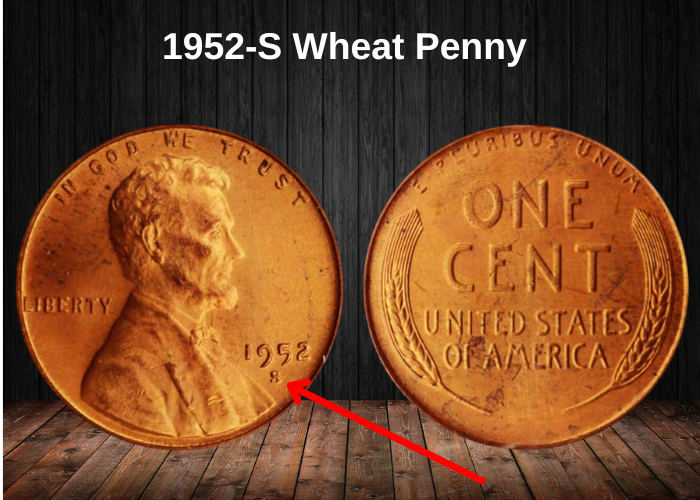
The San Francisco Mint struck 137,800,004 wheat pennies in 1952, which is a relatively high mintage. However, many of these coins were produced using worn or refinished dies, resulting in a somewhat shallow and faint strike compared to those from Philadelphia and Denver.
As with the 1952 Philadelphia and Denver wheat pennies, 1952-S red wheat pennies are generally worth close to their face value in circulated condition, ranging from $0.05 to $0.35.
However, the situation changes with uncirculated examples, which see more noticeable value increases:
- A MS64 can typically be found for around $18.
- A MS66 will cost about $35.
- A MS65 example is priced around $24.
- Rare MS67 examples can fetch up to $175.
The price differences between mint state grades reflect the rarity of these coins in higher-quality conditions. While these coins are common in lower mint states, finding them in gem condition or higher mint states is far more challenging, making such pieces significantly more valuable.
1952 Proof Wheat Penny Value

In addition to regular wheat pennies, the Philadelphia Mint produced proof coins for collectors. A total of 81,980 proof coins were struck in 1952.
Among these, 1952 proof wheat pennies are especially rare in cameo and deep cameo finishes. After the 1951 proof wheat pennies, those from 1952 are the hardest to find in these two categories. According to the Professional Coin Grading Service (PCGS), there are only around 150 to 170 known examples of Cameo 1952 proof wheat pennies, and only ten are graded as Deep Cameo.
While a typical 1952 proof wheat penny is worth about $2,750, the value skyrockets for rare examples in superior condition. For instance, a PF68 Deep Cameo was auctioned for an astounding $64,625 at a 2021 Legend Rare Coin Auctions sale.
Rare 1952 Wheat Penny Errors List
A doubled die obverse error happens when the anvil die strikes the planchet twice at slightly different angles, causing the design elements to appear doubled.
This error is relatively common among 1952 wheat pennies, especially those minted at the Denver Mint. The doubling can be seen on various obverse features, including the word LIBERTY, the date, and even on Lincoln’s beard and the top of his head.
The value of a 1952 wheat penny with a doubled die obverse can range between $100 and $200, depending on the visibility and extent of the doubling.
1952 Struck Through Obverse Wheat Penny Error
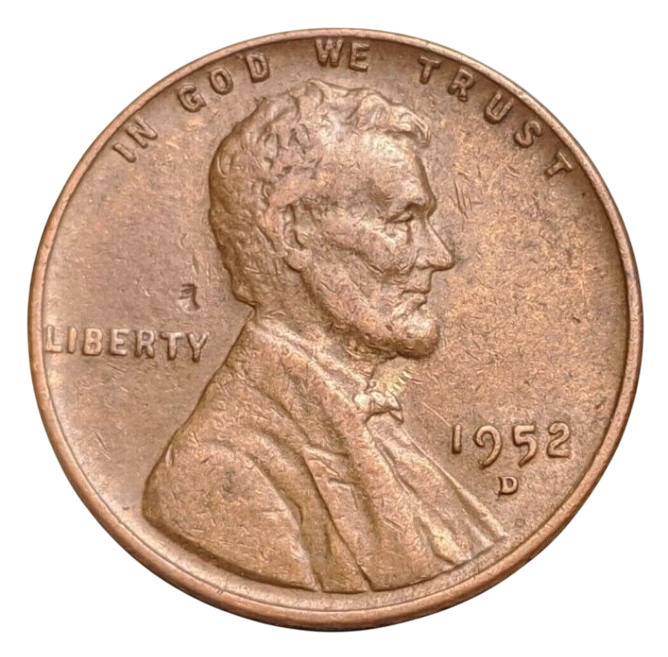
A struck-through obverse error is quite rare in the 1952 wheat penny series, which makes it valuable when found.
This error happens when a foreign object, like grease, a piece of hair, or even dust and debris, gets between the striking anvil and planchet. As the die strikes the planchet, the foreign element leaves an impression on the coin, resulting in a strike-through effect.
If you come across a 1952 struck-through obverse wheat penny, it can be worth up to $100.
1952 Off-Center Strike Wheat Penny Error

An off-center strike error occurs when the planchet (the blank metal disc) is not properly aligned with the die during striking. As a result, the design elements are struck away from the center of the coin, creating an offset.
The value of an off-center strike error depends largely on how far off-center the design elements are. The more offset the design is (in terms of percentage), the more valuable the coin becomes.
- A 50% off-center strike error can be worth as much as $200.
- On the other hand, a coin with a 5% off-center error might only be worth about $30.
Where to sell your penny?
Now that you know the value of your penny, you might be wondering where to sell it. Don’t worry: here’s a guide to some of the best online platforms where you can easily sell your coins, along with their advantages and disadvantages.
Discover the best platforms for selling coins online (pros and cons).
FAQ about the 1952 Wheat Penny
1. Why is the 1952 Wheat Penny important in U.S. coinage history?
The 1952 Wheat Penny is significant because it represents one of the final years of the Wheat reverse design, which was used on U.S. pennies from 1909 to 1958. The following year, in 1953, the U.S. Mint switched to the Lincoln Memorial reverse design, ending the Wheat design era. As a result, the 1952 penny is one of the last to feature the classic Wheat reverse before the transition.
2. What is the metal composition of the 1952 Wheat Penny?
The 1952 Wheat Penny is made of:
- 95% copper
- 5% zinc
This was the standard composition used for U.S. pennies from 1909 until 1942 and again from 1944 to 1958, before the U.S. Mint transitioned to a copper-plated zinc alloy in the 1960s.
3. How many 1952 Wheat Pennies were minted?
The 1952 Wheat Penny had a relatively large mintage:
- Philadelphia (no mintmark): 1,083,410,000
- Denver (D): 160,745,000
- San Francisco (S): 73,365,000
With a total mintage of over 1.31 billion pennies, the 1952 Wheat Penny is one of the most common in the Wheat series, especially in circulated condition. However, coins in mint condition or those with errors can still be valuable to collectors.
4. What is the value of a 1952 Wheat Penny today?
The value of a 1952 Wheat Penny varies depending on its condition:
- Circulated coins: Typically worth around $0.05 to $0.25.
- Uncirculated coins: Those in MS-63 or MS-64 grade can be worth $1 to $10.
- High-grade coins (MS-65 or higher) can be worth $15 to $30. Coins graded MS-66 or better might be worth $40 or more, depending on the quality and rarity.
Since the mintage is high, the most valuable coins are those that are in pristine or error-prone conditions.
5. Are there any notable error varieties in the 1952 Wheat Penny?
Yes, several error varieties are notable for the 1952 Wheat Penny:
- Double Die Obverse (DDO): Some 1952 pennies show a doubled die on the obverse, particularly on the “LIBERTY” and “IN GOD WE TRUST” inscriptions. These doubled die errors are collectible and can be worth significantly more than a regular coin.
- Off-center Strikes: Like many other years, some 1952 pennies were struck off-center, resulting in part of the design being missing or misaligned.
- Die Cracks and Cuds: Some 1952 pennies feature die cracks, where the die that struck the coin was damaged, or cud marks, which are raised areas caused by a damaged die. These are collectible errors that can add value.
Error coins from this year can be worth a premium, especially in higher grades or with unique characteristics.
6. How does the 1952 Wheat Penny compare to other years in the Wheat series?
The 1952 Wheat Penny shares many similarities with other pennies from the early 1950s, but it is one of the last coins to feature the Wheat reverse design before the transition to the Lincoln Memorial reverse in 1959.
Compared to earlier years in the Wheat series, the 1952 penny is still quite common. However, it’s more significant than earlier coins because it marks the final years of the Wheat design. The 1951 penny and 1952 penny are the final two coins in this series, making them desirable to collectors who specialize in Wheat pennies.
7. How can I identify a high-grade 1952 Wheat Penny?
To identify a high-grade 1952 Wheat Penny, collectors should look for:
- Sharp details: The wheat stalks, Lincoln’s portrait, and inscriptions (“LIBERTY” and “IN GOD WE TRUST”) should be clear and well-defined. There should be no wear or fading, especially on the high points like Lincoln’s cheek and the wheat heads.
- Minimal wear: A high-grade coin will show no wear on the major details. The coin will appear almost as if it has never been in circulation. An uncirculated coin will have a fresh appearance with no noticeable flattening or fading of details.
- Smooth, clean surfaces: The coin should be free from scratches, abrasions, or tarnish. The surfaces should be smooth, reflecting light evenly without noticeable flaws.
- Luster: The coin should exhibit a bright luster, which is the coin’s shiny surface from being freshly minted. High-grade coins will have a noticeable luster that remains intact even in circulated specimens.
Coins graded MS-65 or higher, with a prominent shiny luster and sharp details, are highly sought after by collectors.



















































